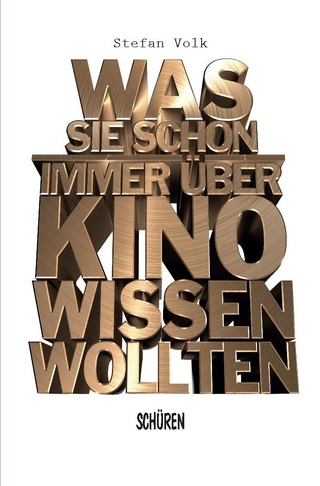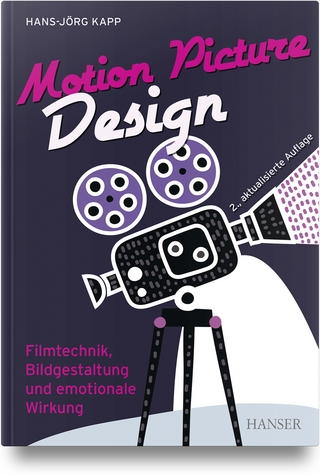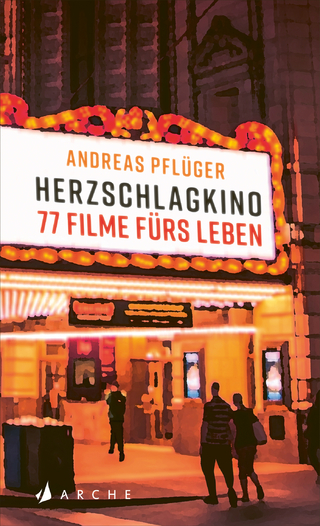
Motion Picture and Video Lighting
Routledge (Verlag)
978-1-138-61801-5 (ISBN)
- Titel erscheint in neuer Auflage
- Artikel merken
This revised edition of Motion Picture and Video Lighting is the indispensable guide to film and video lighting. Written by an experienced professional, this comprehensive book explores light and color theory, equipment, and techniques to make every scene look its best, and is heavily illustrated throughout.
Three new chapters discuss best practices of using light to benefit your film, and an extensive appendix includes discussion on additional tips and tricks. In addition, a robust companion website includes up-to-date video tutorials and other resources for students and professionals alike.
Three new chapters:
Scene Lighting
Lighting as Storytelling
Controlling Light
Topics include:
Lighting sources
The lighting process
Lighting basics
LED, tungsten, Kino-Flo, HMI, and plasma lights
Methods of controlling light
Planning your lighting
The basic methods: a lighting playbook
Visual storytelling with light
Understanding and controlling color
Terminology
Electricity and distribution
Gripology
Set operations
The team: DP, gaffer, grips, lighting technicians
Technical issues
Lighting for greenscreen/bluescreen
Typical equipment orders for large and small jobs
Lighting for high speed and macro photography
Lighting plans for small, medium, and large films
Blain Brown was educated at C.W. Post College, MIT, and Harvard Graduate School of Design. He began in New York as a commercial still photographer before starting in the film business. After working as a gaffer, be became a cinematographer doing primarily commercials and music videos. After completing his first feature film, he moved to Los Angeles where he has been Director of Photography on 14 feature films as well as national commercials, promotional films, industrials, music videos, and documentaries. He has worked in many states in the U.S. as well as Mexico, Canada, India, Italy, France, the Philippines, and Jordan. His experience includes 35mm and 16mm projects, as well as 24P High Def, DigiBeta, BetaSP, and DV. He has completed projects as a director, editor and screenwriter; with three screenplays produced. He has also taught courses in storytelling and visual communication. As a Director of Photography specializing in features and commercials, he is now based in Los Angeles. His books include A Sense of Place; Cinematography; and The Filmmaker's Pocket Reference. His work can be seen at www.BlainBrown.com.
HISTORY OF LIGHTING
Controllable Light
Early Film Production
Introduction of Tungsten Lighting
The Technicolor Era
HMI, Xenon, Fluorescent, and LED Sources
Kino Flo
LEDs
LIGHTING SOURCES
Types of Lights
Fresnels
LEDs
Efficiency
LED Panels
LED Fresnels
Remote Phosphor LEDs
Tungsten Fresnels
The 10K and 20K/24K
The 5K
Juniors
1K
650, Betweenie, and InBetweenie
Inkie
HMI Units
12K and 18K
6K and 8K
2.5K and 4K
Smaller HMIs
When an HMI Fails to Fire
Care and Feeding of HMIs
Xenons
Open Face Lights
Skypan
2K Open Face
1000/600/650 Watt Open Face
Par 64
PAR Groups
Dino, Moleeno, and Wendy
Maxi-Brute
FAYs
HMI PARs
Soft Lights
Space Lights
Fluorescent Rigs
Color Correct Fluorescent Units
Color Correct Bulbs
Cycs, Strips, Nooks, and Broads
Plasma Lights
Other Types of Sources
Chinese Lanterns
Lekos
Crane Mounted Lights
Jokers
Dedolights
Balloon Lights
Barger Lights
LIGHTING BASICS
The Fundamentals of Lighting
The [Conceptual] Tools of Lighting
The Attributes of Light
What are the Goals of Good Lighting?
Full Range of Tones
Shape
Separation
Depth
Texture
Mood and Tone
Exposure and Lighting
Hard vs. Soft
Color Control and Color Balance
Some Lighting Terminology
Working With Hard Light And Soft Light
Hard Light
Soft Light
Direction
Avoiding Flat Front Lighting
Light from the Upstage Side
Backlight and Kicker
Intensity
Adding Texture in Lighting
Color
Lighting Techniques
Classical Hard Light
Ambient
Bringing it Through the Windows
Motivated Lighting And Practicals
Motivated Light
Lighting with Practicals
Available
Basic Principles of Lighting
Back Cross Keys
Ambient Plus Accents
Lighting Through the Windows
Available Light Windows
Day Exteriors
Open Shade and Garage Door Light
Sun As Backlight
Magic Hour
CONTROLLING LIGHT
Hard Light and Soft Light
Fill for Day Exteriors
Silks and Diffusion
Scrims and Barndoors
Flags, Solids, and Nets
Chimeras and Snoots
Softboxes
Eggcrates
The Window Problem
ND For Windows
Cookies, Celos, and Gobos
Dimmers
LED Dimmers
Hand Squeezers
SCENE LIGHTING
Lighting Plans
General Principals of Scene Lighting
Let’s Look at These One by One
Read the Script
Confer With the Director
Light the Scene, Not the Set
Insist on Seeing a Full Rehearsal
Insist on Having Lighting Stand-Ins
What Are the Opportunities?
The Set
The Action
Script Hints
Consider Your Resources
Lights
Power
The Location
The Director’s Concerns
The Plan
Lighting a Scene With Practicals
Lighting/Grip Order
LIGHT AS STORY
Storytelling With Light
Metaphor
Atmosphere
The Power of Darkness
Establish Character
COLOR
Color Terminology
Color Temperature: The Balances
Warm and Cool
Magenta vs. Green
The CIE Diagram
The Spectral Locus
The White Point
The Line of Purples
Color Balance with Gels and Filters
Conversion Gels
Light Balancing Gels
CTO
CTB
Color Correction Gels
Dealing with Fluorescent Light
Correcting Off-Color Lights
HMI
Industrial Lamps
Camera Filtration for Industrial Sources
Measuring Color
Color Meters
The Vectorscope
Calibration Test Charts
DSC Labs Test Charts
The One Shot
The X-Rite ColorChecker
Color as a Storytelling Tool
EXPOSURE
Exposure Theory
What Do We Want Exposure to Do for Us?
The Bucket
Controlling Exposure
Change the Bucket
The Elements of Exposure
Light
F/Stops
The Response Curve
Underexposure
Overexposure
Correct Exposure
Higher Brightness Range in the Scene
Two Types of Exposure
The Bottom Line
Exposure in Shooting RAW Video
The Tools of Exposure
The Incident Meter
The Reflectance Meter
A Different World of Exposure
Setting Exposure with the Waveform Monitor
F/Stops on the Waveform
Exposure Indicators in the Camera
Zebras
Histogram
Traffic Lights and Goal Posts
Goal Posts
Traffic Lights
False Color Exposure Display
Red False Colors
Comparing Red Exposure Modes
Arri Alexa False Colors
Strategies of Exposure
Don’t Let It Clip, but Avoid the Noise
Texture & Detail
The Dilemma
Using Light Meters
Meter the Key
Using the Waveform Monitor
Placing Middle Gray
Start at the Bottom or Start at the Top
Expose to the Right
Zebras
The Monitor
Know Thyself and Know Thy Camera
ELECTRICITY & DISTRO
Measurement of Electricity
Potential
Paper Amps
Electrical Supply Systems
Single-phase
Three-phase
Power Sources
Stage Service
Generators
Large Generator Operation
Guidelines For Running Small Generators
Paralleling Small Generators
Does Paralleling Cause Damage to Generators?
Tie-ins
Tie-in Safety
Determining KVA
Wall Plugging
Load Calculations and Paper Amps
Ampacity
Color Coding
The Neutral
Distribution Equipment
Tie-in Clamps
Busbar Lugs
Connectors
Bull Switches
Feeder Cable
Wire Types
Wire Designation Codes
Distribution Boxes
Lunch Boxes, Snake Bites, and Gangboxes
Extensions (Stingers)
Zip Extensions
Planning a Distribution System
Balancing the Load
Working with DC
Calculating Voltage Drop
Electrical Safety
Wet Work
HMI Safety
Grounding Safety
GFCI
How Does a GFCI work?
GRIPOLOGY
Definitions
Light Controls
Reflectors
Operating Reflectors
Flags and Cutters
Flag Tricks
Nets
Net Tricks
Cuculoris (Cookies)
Grids and Eggcrates
Open Frames
Diffusers
Butterflies and Overheads
Overhead Rules
Griff
Holding
Grip Heads and C-Stands
C-Stand Rules
Highboys
Clamps
Studded C-Clamps
C-Clamp Tips
Bar Clamps
Pipe Clamps
Cardellini and Mafer Clamps
Quaker Clamp
Wall Plates, Baby Plates, and Pigeons
2K Receivers and Turtles
Side Arms and Offset Arms
Other Grip Gear
Sandbags
Apple boxes
Wedges
Candle Sticks
Studded Chain Vise Grips
SET OPERATIONS
The DP
The Team
Gaffer
Assistant Chief Lighting Technician
Third Electric and Electricians
Other Responsibilities
The Key Grip
Grips
Other Crews
Set Operations
Load-In
Staging
The Generator
Cabling
The Process
Rough-In
Blocking
Light
Rehearsal
Shooting
Procedures
Expendables
TECHNICAL ISSUES
Lighting for Greenscreen and Bluescreen
Greenscreen/Bluescreen Tips
Lighting for Process Photography
Flicker
The Power Supply
Flicker-Free HMIs
Dimmers
Dimmer Systems
DMX
Working with Strobes
Strobe Exposure
Lighting and Exposure for High Speed Photography
Exposure
Flicker in High-Speed Photography
Lighting With HMIs and High Speed
Tips for Lighting High-Speed with HMIs
Exposure for Macrophotography
Depth-of-Field in Close-up Work
Lighting for Extreme Close-up
Underwater Filming
Effects
Rain
Smoke
Fire
TV and Projector Effects
Day-for-Night
Moonlight Effect
Water Effects
Lightning
Using the Sun
APPENDIX
Typical Lighting Order For A Small Independent Film
Equipment Order List For a Large Studio Film
Order for a 2nd Unit Night Shoot—Big Budget Film
Light Loss For Common Diffusion Types
Effect Of Diffusion on Color Temp
Lamps and Sockets
Lighting Expendables Order Form
Building Your Own Hand Squeezer
A Typical 5-Ton Truck Package
INDEX
| Erscheinungsdatum | 02.10.2018 |
|---|---|
| Verlagsort | London |
| Sprache | englisch |
| Maße | 190 x 266 mm |
| Gewicht | 1065 g |
| Themenwelt | Kunst / Musik / Theater ► Film / TV |
| ISBN-10 | 1-138-61801-2 / 1138618012 |
| ISBN-13 | 978-1-138-61801-5 / 9781138618015 |
| Zustand | Neuware |
| Haben Sie eine Frage zum Produkt? |
aus dem Bereich



